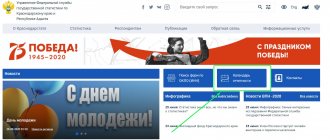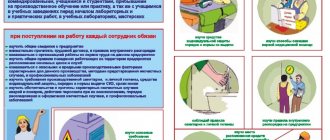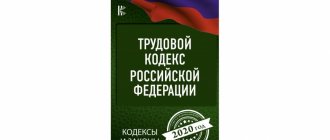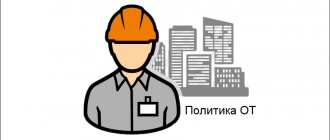Sections of the job description of the head of the labor protection department
When putting a job description into effect, you need to be guided by the rule: the instructions are developed for the position, and not for the person occupying it.
Whoever heads the labor protection department will perform the duties and bear the rights set forth in the instructions. Therefore, a candidate for a position must meet the requirements also set forth in the instructions for this position. When drawing up a job description for the head of the labor protection department, you can include the following sections:
- general provisions,
- labor functions,
- job responsibilities,
- rights,
- responsibility.
And now more about each of these sections: what they are, what information they include. Please note that the following information is presented taking into account the updated qualification characteristics of the position, enshrined in the order of the Ministry of Health and Social Development No. 559n dated May 17, 2012. By this order, new titles were included in the Unified Qualification Directory of Positions, including “Head of the Labor Safety Service” (instead of the position of “Head of the Labor Safety Department”).
General provisions of the instructions
This section of the instructions contains general information about the position. Here it is written:
You can find more complete information on the topic in ConsultantPlus. Free trial access to the system for 2 days.
- what is the name of the position?
- who hires the employee,
- who can fire him?
- to whom the employee reports or reports.
Since the position of head of the labor safety service (head of the labor safety department) is in the Qualification Directory of Positions, the requirements for the candidate for the position can be transferred from there to the job description.
According to the Qualification Directory, only a candidate with a higher professional education in the field of “Technosphere Safety” or something similar can now apply for the position described. A candidate who has received education in another specialty will have to undergo retraining or receive additional professional education. There are also requirements for minimum experience; it must be at least 5 years in a position in the field of labor protection.
An employee who is hired as the head of the labor protection department must be aware of the content of a number of regulations governing relations in the field of labor protection, as well as the standards and requirements for workplace safety prescribed there. In addition, he must become familiar with the technological processes used in production and the rules for operating the equipment installed there.
Taking this information into account, the “General Provisions” section may consist of the following items:
- position title – head of the labor protection department (head of the labor protection service),
- chain of command,
- qualification requirements,
- knowledge that an employee must have.
Who is responsible for safety precautions?
Among workers who are superficially familiar with occupational safety requirements, there is an opinion that the occupational safety and health engineer is responsible for their safety. Actually this is not true. Their immediate supervisor is responsible for the safety of specific employees. Managers of the enterprise, divisions, departments, etc. are generally responsible for occupational health and safety at the enterprise. Responsibility for compliance with occupational health and safety requirements at the enterprise is also divided according to the areas of supervision and assigned to employees of relevant competence. For example, energy service employees appointed by orders are responsible for electrical safety; immediate supervisors are responsible for organizing a system of briefings on labor protection and safety at workplaces and its quality functioning. The workers themselves are obliged to take care of their own safety. This is a requirement not only of common sense, but also of Art. 214 Labor Code of the Russian Federation. To stay healthy and work, workers need to:
• clearly know and constantly comply with the requirements of safety and labor protection instructions; • complete training and medical examinations on time; • use PPE; • be able to provide first aid; • carefully monitor the environment, analyze production situations and immediately report to the work manager about possible or existing dangers. Safety and Health Engineer
During training, medical examination, or work stoppage due to a dangerous situation, the worker retains his average earnings. If he evades responsibility for his own health - does not attend instructions on occupational health and safety, does not undergo medical examinations, regularly violates occupational safety requirements - the employer’s representatives have the right to remove him from work in the appropriate manner. However, no wages are accrued during this time. What is the occupational safety service responsible for? The area of responsibility of the occupational safety service, which can be represented even by a single engineer, is the organization of occupational health and safety at the enterprise. Representatives of this service are obliged to:
1. Organize an investigation, recording of NS, PP, analysis of the causes of their occurrence, development of preventive measures; 2. Create and implement programs and activities to improve the quality of working conditions; 3. Provide organizational and methodological support to departments in the field of occupational safety: help develop instructions on safety and labor protection, store their control copies, provide departments and management employees with instructions, magazines, cards, other documentation on occupational safety, visual aids, rules, regulations; 4. Participate in testing workers’ knowledge based on the results of occupational safety training conducted by the enterprise; 5. Help prepare any documents that relate to labor protection and safety at work: collective agreement, various agreements, orders for calls to work on weekends, changes in schedule, etc.; 6. Help make lists for:
• passing pre-shift, preliminary and annual medical examinations; • receiving milk, special food; • issuance of protective clothing and personal protective equipment; • receiving compensation (preferential pension provision, additional leave);
7. Prepare and submit labor safety reports; 8. Store OT documentation; 9. Organize training on occupational safety for employees and managers; 10. Regularly check the health status in departments; 11. Conduct introductory briefings on labor protection and safety precautions.
In order to effectively monitor compliance with occupational health and safety requirements at work, occupational safety specialists can at any time: • inspect machinery, equipment, and premises; • check occupational safety documentation (keeping logs, familiarizing workers with occupational health and safety instructions, maintaining workwear and personal protective equipment accounting cards, issuing work permits, etc.), the availability of personal protective equipment and their actual use; • monitor the use of safe practices and work methods by workers. In order to successfully carry out the tasks assigned to them, occupational safety specialists cooperate with other services of the enterprise (human resources, power engineers, mechanics, first aid station, etc.), as well as the occupational safety commission, employees’ representatives on occupational safety issues, and the trade union.
Labor function of the head of the labor protection department
Naturally, the head of a department heads his department and coordinates the work of the employees working in it. But he is also responsible for organizing work on occupational safety throughout the enterprise, for which he gives individual instructions to his employees and monitors the progress of their implementation.
Subscribe to our newsletter
Yandex.Zen VKontakte Telegram
The head of the labor safety department approves a list of labor safety requirements at the enterprise, which all employees must adhere to, and he participates in the development of local acts where they are enshrined. At the same time, it is the boss who interacts with the management of other services to ensure maximum safety of production processes.
III. Job responsibilities
Head of Labor Safety Department:
3.1. Organizes and coordinates work on labor protection at the enterprise, monitors compliance in structural units with legislative and regulatory legal acts on labor protection, carries out preventive work to prevent industrial injuries, occupational and work-related diseases, measures to create healthy and safe working conditions at enterprise, for providing employees with established benefits and compensation for working conditions.
3.2. Organizes the study of working conditions at workplaces, measures the parameters of dangerous and harmful production factors, certification and certification of workplaces and production equipment for compliance with labor protection requirements, monitors the timeliness of planned activities.
3.3. Participates in the investigation of accidents at the enterprise and the development of measures to prevent them.
In the event of an accident at work, takes immediate measures to prevent the development of an emergency situation and the impact of traumatic factors on other persons.
3.4. Informs employees on behalf of the employer about the state of working conditions in the workplace, as well as about measures taken to protect against dangerous and harmful production factors, ensures the preparation of documents for the payment of compensation for harm caused to the health of employees as a result of an industrial accident or occupational disease.
3.5. Organizes inspections and surveys of the technical condition of buildings, structures, equipment, machines and mechanisms for compliance with the requirements of regulatory legal acts on labor protection, checks of the efficiency of ventilation systems, the condition of sanitary facilities, collective and individual protective equipment for workers. Monitors the timeliness of these checks.
3.6. Ensures the participation of department employees in the preparation and submission of proposals for the development and implementation of more advanced designs of fencing equipment, safety and locking devices, and other means of protection from the effects of hazardous and harmful production factors, the development and implementation of measures to create safe and healthy working conditions, rational working conditions and rest.
3.7. Participates in the drafting of the “Occupational Safety and Health” section of the collective agreement, monitors its implementation, as well as compliance with the instructions of state supervision and control bodies, and other measures to improve working conditions.
3.8. Participates in the coordination of design documentation developed at the enterprise, in the work of commissions for the acceptance into operation of completed construction or reconstructed production facilities, for the acceptance of installations, units and other equipment from repair in terms of compliance with the requirements of regulatory legal acts on labor protection.
3.9. Provides methodological assistance to heads of enterprise departments in compiling lists of professions and positions, according to which employees must undergo mandatory preliminary and periodic medical examinations, as well as lists of professions and positions, according to which, on the basis of current legislation, workers are provided with compensation and benefits for severe, harmful or dangerous working conditions, when developing and revising labor protection instructions, enterprise standards for labor safety.
3.10. Provides introductory and repeated briefings, training and testing of knowledge on labor protection of enterprise employees.
3.11. Monitors the correctness of spending funds on labor protection measures in the divisions of the enterprise, analyzes and summarizes proposals for their expenditure and prepares justifications for the allocation of funds to the enterprise from the territorial labor protection fund for measures to improve working conditions and safety.
3.12. Organizes the work of the labor protection office, propaganda and information on labor protection issues at the enterprise using for these purposes the internal radio network, television, wall newspapers, shop windows, providing the enterprise departments with rules, regulations, instructions, posters and other visual aids on labor protection, and also providing them with methodological assistance in equipping appropriate information stands.
3.13. Brings to the attention of the enterprise's employees the new legislative and regulatory legal acts on labor protection that are being introduced, organizes the storage of documentation on labor protection, the preparation of reports in established forms and in accordance with the deadlines established by regulatory legal acts on labor protection.
3.14. Participates in the consideration of letters, applications and complaints from employees on labor protection issues and the preparation of proposals on them to the employer to eliminate existing shortcomings and omissions identified during investigations, as well as preparing responses to applicants.
3.15. Communicates with medical institutions, research and other organizations on occupational safety issues and takes measures to implement their recommendations.
3.16. Manages department employees.
3.17. [Enter as appropriate].
Job responsibilities of the head of the labor protection department
This section lists the duties that an employee of the enterprise who is employed as the head of the labor protection department must begin to perform. Usually he is charged with:
- organize and coordinate work on labor protection;
- participate in the functioning of the occupational safety management system, while relying on interstate and national standards in force in the field of occupational safety;
- develop a professional risk management system, adjust it due to modernization of technical equipment, changes in legislation;
- organize control over compliance with labor safety requirements in departments;
- organize the provision of information to employees about working conditions at the enterprise and about the personal protective equipment they are required to wear;
- organize control over the condition of collective and individual protective equipment;
- control the systematic training of employees on safety issues in the workplace;
- bring to the attention of the manager information about the needs of personnel for personal and collective protective equipment, monitor the expenditure of money allocated for these purposes;
- participate in organizing and conducting a special assessment of working conditions;
- participate in the investigation of the causes of industrial accidents and occupational diseases encountered by employees, develop and submit for approval to management plans to improve the state of labor protection and minimize occupational risks;
- draw up reports in the prescribed form and submit them as intended;
- manage department employees.
This is an incomplete list of job responsibilities; it can be modified depending on the needs of the company where the corresponding department is organized.
Answer
An occupational safety specialist can combine the responsibilities of those responsible for fire safety, electrical safety (electrical equipment), as well as for anti-epidemic measures and bear the responsibility provided for by law as an official of the organization.
At the same time, the head of the organization is responsible for labor protection, fire and electrical safety, as well as anti-epidemic measures according to his position. And the fact of appointing a responsible specialist does not fully relieve the manager from this responsibility.
Rights of the head of the labor protection department
In order to be able to perform his duties, the head of the labor protection department may be granted the following rights:
- submit proposals on labor protection issues for consideration and approval by management;
- make requests and receive information from company employees, including heads of structural divisions;
- interact with heads of other structural divisions;
- sign (endorse) documents within their competence;
- submit for consideration by management issues of rewarding employees or, conversely, imposing disciplinary sanctions on them for actions committed in the field of labor and production discipline;
- turn to management for assistance in performing your job function.
How to distribute occupational safety responsibilities in an organization
How to distribute occupational safety responsibilities in an organization
Article 212 of the Labor Code establishes the employer’s obligation to ensure the creation and operation of a labor safety management system (hereinafter referred to as the OSHMS).
To this end, the Labor Code obliges each employer to develop and approve a local act - “Regulations on the occupational safety management system”, guided by Order of the Ministry of Labor dated 08/19/2016 No. 438n “On approval of the Standard Regulations on the occupational safety management system” (hereinafter referred to as the Model Regulations ).
Rationale
The OSMS represents the unity of the employer's organizational management structures with the fixed responsibilities of its officials ( clause 4 of the Model Regulations).
One of the main objectives of the “Regulations on the Occupational Safety and Health Management System” is the distribution and assignment of duties and responsibilities in the field of occupational safety among officials of the organization at all levels of management.
Responsibilities in the field of labor protection of the employer's officials are established depending on the level of management. At the same time, at each level of management, responsibilities in the field of labor protection are established personally for each manager or employee participating in management ( clause 21 of the Model Regulations).
The head of the organization, his deputies, heads of structural divisions, etc. (at all levels of management) must have their own responsibilities in the field of labor protection.
The occupational safety service and occupational safety specialists should also have their own responsibilities. But they differ from the responsibilities of higher levels of management (head of the organization, chief engineer, etc.) and from the levels of structural divisions (whose managers are directly involved in production and are directly responsible for the safety of the workers subordinate to them).
For example , the head of a structural unit of the employer ( subparagraph “e”, paragraph 29 ):
· provides working conditions that meet labor protection requirements in the employer’s structural unit;
· ensures the functioning of the OSMS;
· bears responsibility for the improper fulfillment of the duties assigned to him in the field of labor protection;
· distributes responsibilities in the field of labor protection among his subordinates, including delegating to them part of his powers, determining the degree of their responsibility;
· promotes the work of the labor protection committee (commission) authorized by employees of representative bodies;
· ensures the timely conduct, at the expense of the employer, of mandatory preliminary (upon employment) and periodic (during employment) medical examinations, psychiatric examinations, chemical and toxicological studies of employees of the structural unit;
· provides access to independent work for persons who meet the relevant qualification requirements and do not have medical contraindications to this work;
· organizes training on labor protection;
· organizes the issuance of special clothing, special shoes and other personal protective equipment, flushing and neutralizing agents;
· organizes the provision of therapeutic and preventive nutrition and milk to the relevant contingent of employees of the structural unit;
· provides sanitary services and medical support for employees of the structural unit in accordance with labor protection requirements;
· organizes in the structural unit the safety of operation of industrial buildings, structures, equipment, the safety of technological processes and raw materials used in production;
· participates in organizing a special assessment of working conditions.
Based on the requirements for the OSMS in the organization:
· responsibility for the state of labor protection in the organization as a whole is assigned (by decision of the head of the organization) to the deputy manager, chief engineer;
· responsibility for the state of labor protection in the department rests with the head of the department (section, etc.).
Responsibilities of the labor protection service (specialist) ( subparagraph “g”, paragraph 29 ):
· ensures the functioning of the OSMS;
· manages the organizational work on labor protection at the employer, coordinates the work of the employer’s structural divisions;
· organizes the placement in accessible places of visual aids and modern technical means for conducting labor protection training;
· exercises control over the provision of workers in accordance with the Labor Code of the Russian Federation with regulatory legal and methodological documentation in the field of labor protection;
· monitors compliance with the employer's labor protection requirements, labor legislation regarding labor protection, work and rest schedules for employees, instructions and regulations of government authorities based on the results of control and supervisory activities;
· monitors the state of labor conditions and safety;
· organizes the development of measures by the employer’s structural divisions to improve working conditions and labor protection, monitors their implementation;
· carries out operational and consultative communication with government authorities on labor protection issues, etc.
660 07.08.2019 02:13:12
comments powered by HyperComments
Responsibility of the head of the labor protection department
The head of a department is responsible not only for his own actions and decisions, he is also responsible for the actions and decisions of employees working in the structural unit under his control. And if the head of the department himself, or one of his employees, but always with the knowledge and consent of the head of the department, commits an action or makes a decision that is contrary to the law, then for this he can be held liable for the following types of liability:
- to disciplinary – in case of violation of labor duties;
- to administrative or criminal - in case of committing relevant offenses;
- to material – in case of damage within the limits established by civil and labor legislation.
Renaming a position – is it necessary to rewrite the job description?
As mentioned above, in 2012, the Ministry of Health and Social Development, by its order No. 559n, made changes to the Qualification Directory, creating a new section dedicated to positions in the field of labor protection. Previously, the position of head of the labor protection department belonged to the section of general industry positions, and was excluded from the directory in July 2013. So now this position is called “Head of Labor Safety Service”.
In this regard, many personnel workers have a question: is it necessary to rewrite the job description, changing the job title in it? The answer must be sought in the nature of the Qualification Handbook itself as a normative document. The fact is that it is only recommended for use, and not required. Therefore, whether to make changes to the staffing table and whether to develop a new job description is a matter for the management of the enterprise. But with one exception.
If an employee holding the position of head of the labor protection department receives benefits or compensation related to the fact that he works under special conditions, then the title of his position must correspond to the title from the Qualification Directory, and therefore must be changed.
It is worth noting that not only the title of the position has changed - new provisions have also been introduced into the job responsibilities, as well as into the qualification requirements. You need to pay attention to this when developing a new job description.
Summarize. The job description of the head of the labor protection department briefly describes the areas in which the employee’s work activity takes place, how he should coordinate the work of his department, interact with other departments and build relationships with management. Following the provisions of the job description when performing his job function, the boss fulfills the duties enshrined in it, while enjoying a certain scope of rights.






